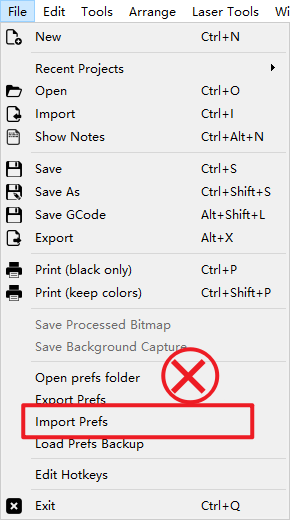Disclaimer
If you need to control xTool F1 through LightBurn, download the official release of the LightBurn software. LightBurn is a third-party software, and therefore Makeblock Co., Ltd. shall bear no responsibility for any loss caused by the operation of LightBurn.
The firmware of xTool F1 has been tested in detail by Makeblock Co., Ltd, but incompatibility with the software or hardware may still occur. You can contact our after-sales service for technical support if errors occur due to incompatibility.
Download and install Lightburn
- Go to https://lightburnsoftware.com/pages/trial-version-try-before-you-buy
- Download LightBurn and install it. If you are a new user, you have a 30-day free trial.
Note: Make sure you use the latest version of LightBurn, and your LightBurn is licensed. If the software is of an early version or is a cracked or pirated version, device connection may fail.
Connect xTool F1 with LightBurn
- Download the configuration file for xTool F1: xTool-F1-V2.2.lbdev
- Open LightBurn. On the Laser panel, click Devices.

Note: Ensure that you start to configure xTool F1 in this way instead of choosing Import Prefs from the menu. If you choose Import Prefs, the original configuration is overridden.
- On the Devices window, click Import to import the configuration file (xTool-F1-V2.2.lbdev).

- The following device information is displayed after the file is successfully imported.

- Connect your computer with xTool F1 by using the USB cable.

Start processing plane materials
- Place a material to be processed in the working area.

Note: You can also take out the removable baseplate and place the material under the base of xTool F1. For more information about how to place materials, see xTool F1 User Manual.
- Turn the knob to move the laser module up and down. When the red and blue light spots coincide, the focus is successfully set.

- On the canvas of LightBurn, design the processing pattern.

- Set the processing parameters.

- Set Start From to Absolute Coords.

- Click Frame to see whether the processing pattern is in the expected area on the material.

- Click Start to start processing your material.

Note: By default, LightBurn uses the blue light laser for processing.
If you want to use the infrared laser, you can click Console. On the Console panel, click the RED_LASER button, or enter M114S2 in the text box and press Enter. Then, click Start, and xTool F1 will start processing by using the infrared laser.
After the infrared laser processing is complete, LightBurn will automatically switch back to the blue-light laser mode.
Start processing cylindrical materials
- Connect and place the rotary attachment on xTool F1.

Note:
For detailed information and instructions on how to use the rotary attachment, see User Manual for Rotary Attachment 2 (RA2).
For more information on how to connect xTool F1 with the rotary attachment, see xTool User Manual.
- Turn the knob to move the laser module up and down. When the red and blue light spots coincide, the focus is successfully set.

- Click General Lightburn Settings on the toolbar.

- On the Settings window, turn on Show rotary enable on the main window, and click OK. Then the Enable Rotary button is displayed on the Laser panel.

- Click Device Settings > GCode. In Start GCode, enter the following commands: G100 and M116A2B-4.

- Select Laser Tools > Rotary Setup.

7. Set the parameters for the rotary attachment as follows and click OK.
Steps:
(1) Choose your rotary type: Chuck or roller.
(2) Enable rotary and "mirror output" (opt-out if you are using roller rotary).
(3) Choose "Y Axis" for the rotary axis (for xTool F1).
(4) Enter the corresponding parameter for rotary attachment.
(5) Enter your object parameters.

8. On the canvas, design the processing pattern and set processing parameters for each object.

9. On the Console panel on the left side, click ROTARY_FRAMING. Click Frame to preview the position of the processing pattern on the material. After everything is ready, click Start.


Note 1: To stop framing, click ROTARY_FRAMING_CLOSE.
Note 2: To turn off the cylindrical processing mode, click the Enable Rotary button to disable it, and then delete the added commands G100 and M116A2B-4 in Device Dettings.
Cautions
- To ensure that xTool F1 works properly with Lightburn during laser processing, you need to set the transfer mode to buffered: on the toolbar, select Edit > Device Settings. Set the Transfer mode to Buffered.

- For an image object, enable Overscanning for it to prevent charred edges.

- You can switch between XCS and LightBurn after turning on xTool F1.

You can visit the website of LightBurn to view more information on how to use LightBurn.
- Video tutorials: https://lightburnsoftware.com/pages/tutorials
- Documentations: https://docs.lightburnsoftware.com/index.html
